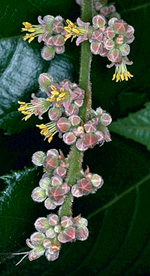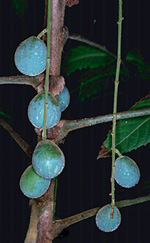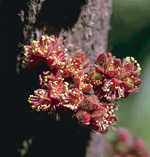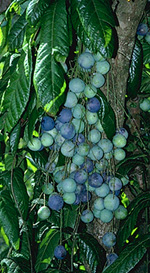 |
This small family (with 2 or 3 species in one family) is endemic to Australia, where it is found in lowland rainforests and on the margins of eucalypt forests adjoining rainforests, in north-eastern New South Wales and south-eastern Queensland.
Characteristic features of the family Davidsoniaceae in Australia include: - small to medium-sized trees with alternate, toothed compound leaves with prominent toothed wings between the leaflets
- flowers small, bisexual, regular, with 4 or 5 sepals fused at the base and no petals
- stamens 8 or 10, alternating with prominent nectaries
- ovary superior with 2 free styles, developing into a large blue to black, plum-like fleshy fruit
Description
Evergreen trees or shrubs. Internal secretions not obvious. Plants with simple, glandular or non-glandular, unicellular hairs. Leaves alternate and spiral, petiolate. Stipules distinct and free from the petiole, green and leafy, persistent; stipellae present. Lamina once compound, imparipinnate, symmetric; leaflets elliptic, oblanceolate, obovate or oblong; base cuneate or attenuate; margins entire or serrate, ±flat; venation pinnate, with the midrib conspicuous, and the tertiary venation reticulate; surfaces not punctate; leathery. All the flowers bisexual. Inflorescences axillary, cauliflorous or ramiflorous, consisting of panicles. Bracts absent. Bracteoles present. Pollination by insects. Flowers stalked. Floral disc absent; nectaries present on the carpels. Perianth regular, of 1 whorl only, with 4–5 fused sepaloid segments, valvate in bud, cup-shaped or bell-shaped, red or pink, herbaceous. Fertile stamens 8 or 10, both alternating with and opposite to the perianth segments, free of the perianth, free of the ovary and style, distinct from each other, all ±equal. Anthers dorsifixed, versatile, opening outwards by pores or by longitudinal slits; 2-celled. Ovary superior and sessile. Carpels 2, fused; ovary with 2 locules. Style terminal, branching from the base. Ovules 5–7 per locule, stalked; placentation apical or axile. Fruit a fleshy, indehiscent drupe; the perianth on the maturing fruit deciduous. Disseminule macro-surface featureless or with straight hairs; micro-surface ±smooth, red, dull. Seeds 2 or rarely 1 per fruit. Aril absent. Cotyledons 2. Embryo straight.
(Note: this description has been generated from the coded data compiled for the key. Any errors in the key data will be reflected in the descriptions.)
A treatment of the family Davidsoniaceae has not yet been published in the Flora of Australia. It will appear in Volume 10.
Australian genera of Davidsoniaceae (as recognised for the Flora of Australia)
Davidsonia

|
  |

Davidsonia pruriens (flowers)
Photo: M.Fagg © ANBG

Davidsonia pruriens (fruits)
Photo: M.Fagg © M.Fagg

Davidsonia pruriens var. jerseyana (flowers)
Photo: H.Nicholson © H. & N. Nicholson

Davidsonia pruriens var. pruriens (fruits)
Photo: H.Nicholson © H. & N. Nicholson
|

| |